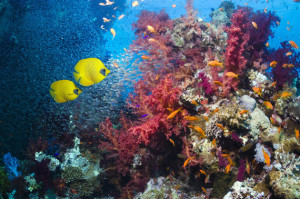What is sunscreen and why do we use it?
The first sunscreen was invented in 1938 by an Austrian scientist named Franz Greiter. Sunscreen was created to protect the skin against ultraviolet radiation from the suns UV-A and UV-B rays, which is the the leading cause of skin cancer. Also known as SPF, Sun Protection Factor, which measures how well the sunscreen is at preventing UVB from damaging the skin. UV-A rays seep deep into the skin and increase reactive oxygen species that can damage the DNA. Meanwhile, UV-B rays only effects the outer most layer of the skin that increases direct photochemical damage to DNA, which mutates genes causing wrinkles and aging of skin.
Sunscreen combines multiple ingredients that help prevent sun’s ultraviolet radiation from penetrating the skin. There are two kinds of active ingredients in sunscreen, mineral and chemical filters. Chemical filters include: oxybenzone, avobenzone, octisalate, octocrylene, homosalate and octinoxate. Mineral sunscreens use zinc oxide and/or titanium dioxide.
Effects of Sunscreen on the Human Body
To explain the chart above,
In two European studies by Margaret Schlumpf of the University of Zurich in 2008 and 2010 she found sunscreen chemicals in mothers’ breastmilk, potentially exposing the fetus. In Schlumpf’s 2010 study she discovered that 85 percent of the milk samples she collected contained at least one sunscreen chemical.
In 2008 the Federal Centers for Disease Control and Prevention tested a sample of more than 2,500 Americans and found that more than 96 percent of them contained traces of Oxybenzone. The researchers noticed that their participants had a significantly higher concentrations of Oxybenzone in their bodies during the summer which led them to concluded that the application of sunscreen was the cause.
But according to the National Oceanic and Atmospheric Administration (NOAA) not only is sunscreen a danager to humans it has also been reporter to be destroying our coral reefs.
The NOAA said that” this is the third time in history, the world is in the midst of a global coral bleaching event.” When scientists conducted studies in Hawaii and the U.S. Virgin Islands they discovered that oxybenzone was extremely harmful to the coral reefs. According to The Washington Post a very small amount of oxybenzone is needed to harm the coral in fact they said there only needs to be “the equivalent of a drop of water in a half-dozen Olympic-sized swimming pools” to cause sufficient harm. Lead researcher Craig Downs said that from approximately 14,000 tons of sunscreen ending up in the coral reef each year 80 percent of the coral reef has been destroyed!
What can we do to stop this?
Coral reef animals and plants have been a gold mine for finding new cures and medicine in the 21st century. So, the U.S. National Park Service strongly encourages us to use “reef-friendly” sunscreen that doesn’t contain oxybenzone to help preserve our coral reef.
Work Cited
http://www.huffingtonpost.ca/dr-mike-hart/does-sunscreen-cause-cancer_b_3280578.html
http://www.huffingtonpost.com/entry/sunscreen-coral-reefs_56274317e4b08589ef49bf67?utm_hp_ref=science&ir=Science§ion=science
http://www.cdc.gov
http://www.doctoroz.com/article/your-sunscreen-might-be-poisoning-you
http://www.skincancer.org/prevention/sun-protection/sunscreen/sunscreens-explained
http://www.ewg.org/2015sunscreen/report/the-trouble-with-sunscreen-chemicals/
http://www.sun-protection-and-products-guide.com/who-invented-sunscreen.html




Pingback: The Hidden Dangers of Chemical Sunscreen & What To Use Instead!! – FITFOODTEAM
Pingback: The Hidden Dangers of Chemical Sunscreen & What To Use Instead
Being a person of exceedingly pale complexion, I find it somewhat inconvenient to go out of the way and purchase sunscreen just because it is simply “environmentally friendly.” Regardless, what do you think the solution to this pressing problem is? I think we can all agree that it is an imperative to protect and preserve our environment, but economic costs often get in the way of that. Would you propose better governmental regulation of the sunscreen industry? What are a few sunscreen compounds that work just as well as the chemical in question. I read somewhere that the Romans use to use pig fat as a method to protect against the sun. Would organic components be cheaper? Would they be more effective?
I never really thought about sunscreen having adverse affects. Growing up it was just sort of forced on us as kids because parents did not want us to get burned. I guess using sunscreen, just like anything in life, has its risks, and it is important to evaluate risk. As of now, however, I see my exposure to oxybenzone as only having soft end points. Currently, I could not find any articles that lead to any severe health deterioration or death as a result of the limited exposure to oxybenzone. The alternative would be not using sunscreen and getting burned. Getting burned is also a soft end point, but extensive exposure to the sun may cause skin cancer, which may lead to death. As of know, I would risk being exposed to oxybenzone to protect myself from the sun.
This was an interesting aspect to the effect of sunscreen that I didn’t even know existed. I had always heard of people having allergic reactions as a direct correlation of certain types of sunscreens, but I had no idea that it was so damaging to sea life and even mother’s breast milk! How the hell did sunscreen get in there? The chemicals seeped through the pores on a woman’s breast? So, I did some research and found this article that goes into detail about the dangerous chemicals that come from inside a sunscreen bottle and it’s effect on our bodies.